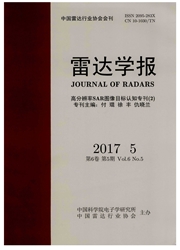

 中文摘要:
中文摘要:
高速弹头目标成像是雷达领域的研究热点与难点。不唰于常规目标,高速弹头在沿弹道运动的同时常伴随特定的白旋运动,使得雷达『回波包含的多普勒信息更为复杂,对雷达高分辨成像提出了更为严峻的挑战。针对这一难题,该文从3个层面对基于自旋运动的高速弹头成像方法进行了研究。首先研究了具有轨道运动并伴随白旋运动高速弹头的雷达回波特性,揭示了回波相位信息的变化特点;其次,基于回波特性分析结果,提出了一种基丁Wigner—Hough变换(WHT)的自旋弹头目标回波轨道运动补偿方法以及基于自旋运动的成像方法;最后,利用仿真数据对提出方法的有效性以及基于自旋运动成像方案的优势进行了测试,结果表明:在达到一定信噪比时该文成像算法性能稳健,较好地解决了高速弹头的速度估计难题和成像算法的复杂性问题。
 英文摘要:
英文摘要:
Currently, high-resolution imaging of a high-speed warhead is a popular topic in the field of radar technology. In contrast with regular targets, a high-speed warhead often moves along its trajectory and simultaneously exhibits a special spinning movement. The echoes from a radar sensor can contain complex Doppler information presenting a severe challenge to the high-resolution imaging procedure. This paper investigates imaging methods for a high-speed warhead considering the spinning movement. First, the radar echo characteristics of the spinning warhead are studied and the echo phase characteristics are revealed. Next, the chirp-rate estimation method using the Wigner Hough Transform (WriT) for the trajectory movement compensation and the imaging method based on spinning are proposed. Finally, the validity and the advantage of the spin-based imaging method are tested with simulation data. Test results indicate that the imaging algorithm is robust when the data reaches a certain SNR, and this paper provides a better solution to the issue of speed estimation and the complexity of imaging algorithm of a high-speed warhead.
 同期刊论文项目
同期刊论文项目
 同项目期刊论文
同项目期刊论文
 期刊信息
期刊信息
